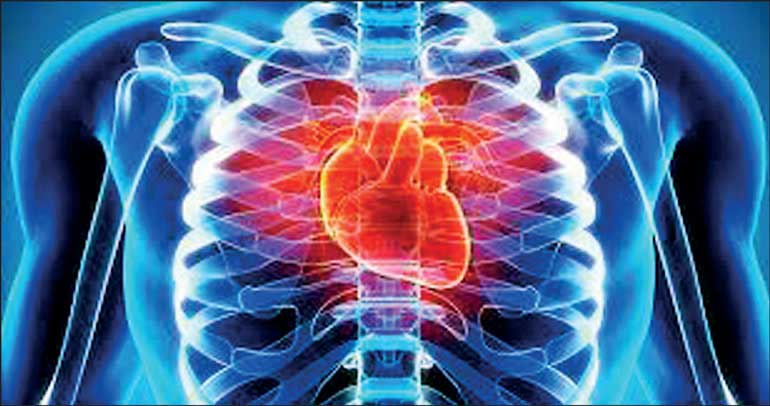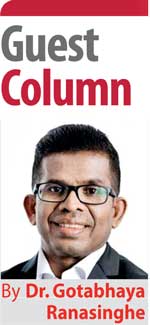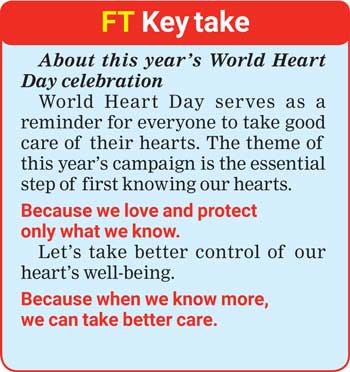Tuesday Apr 22, 2025
Tuesday Apr 22, 2025
Saturday, 14 October 2023 02:06 - - {{hitsCtrl.values.hits}}
 As we commemorate this year’s World Heart Day, I thought how exciting
As we commemorate this year’s World Heart Day, I thought how exciting
it is that new technologies and innovations enable us to transform cardiovascular care
Over time, fewer heart operations may be necessary thanks to the early diagnosis of cardiac problems. Better treatment options for heart patients would be made available through advanced diagnostics, technologically driven non-surgical and surgical treatments, high-tech healthcare delivery systems, digital patient monitoring and follow-up procedures, super-fast effective communications, and clinical research
 New technologies are transforming the field of cardiology, making it possible to improve heart and circulatory disease treatment and prevention. Scientists and biomedical researchers concentrate on creating smarter medical equipment. Technologies in development include implantable pulse generators, heart prosthetics, genomic analysis, and AI-powered diagnostics.
New technologies are transforming the field of cardiology, making it possible to improve heart and circulatory disease treatment and prevention. Scientists and biomedical researchers concentrate on creating smarter medical equipment. Technologies in development include implantable pulse generators, heart prosthetics, genomic analysis, and AI-powered diagnostics.
How does a pulse generator help your heart?
A cardiac pulse generator is a device with a power supply and electronic circuitry that generates output stimuli. Simply said, to stimulate the heart, current from the pacemaker’s battery goes through a connecting pathway before returning to the pacemaker to complete the circuit. Pulse generators improve heart function, conquer certain malignant arrhythmia conditions, and prevent cardiac arrest.
They are used in the forms of AICD (Automatic Implantable Cardioverter Defibrillators) or CRT-D (Cardiac Resynchronisation Therapy [CRT] device).
How heart prosthesis help the heart
Mechanical and bioprosthetic (also known as tissue) valves are two broad categories of artificial heart valves intended to mimic the function of natural valves by ensuring unidirectional blood flow.
Cardiovascular prosthetic devices are implantable or external devices that replace or help the heart, the arteries, or veins, among other cardiovascular system components.
TAVI -Transcatheter aortic valve implantation (TAVI) is a minimally invasive procedure commonly conducted under local anesthetic. TAVI is used to treat patients ailing from aortic stenosis, a form of valvular heart disease that affects the heart valves (failing heart valve).
Recently, together with my team I successfully performed the first-ever TAVI procedure in Sri Lanka, and am glad to say the patient has recovered fully.
I fervently urge the Sri Lankan Government and those in private-sector healthcare to embrace the TAVI procedure as it is the most effective treatment for individuals suffering from aortic stenosis. The entire world, including our neighboring country, India, is enthusiastically endorsing this procedure.
 Latest innovations in coronary stent technology
Latest innovations in coronary stent technology
Coronary stent technology has advanced speedily and is now a vector for local medication delivery and alteration of the coronary plaque composition and its behaviour.
Drug-eluting stents (DES)
Drug-eluting stents stop the growth of new endothelial cells, inhibit cell wall growth, and thereby prevent re-narrowing of the arteries.
Optical coherence tomography (OCT)
During percutaneous coronary intervention (PCI), OCT, an intravascular imaging method, uses near-infrared light to provide high-definition, cross-sectional, and three-dimensional pictures of the artery microstructure. It helps to analyse the size of the lumen, plaque load, and composition in detail, that is useful for treatment planning. It also offers information on the architecture of the coronary arteries.
I fervently urge the Sri Lankan Government and those in private-sector healthcare to embrace the TAVI procedure as it is the most effective treatment for individuals suffering from aortic stenosis. The entire world, including our neighboring country, India, is enthusiastically endorsing this procedure
Intravascular ultrasound (IVUS)
The aorta and coronary arteries (the blood vessels that carry blood to the heart) can be seen in amazing detail thanks to IVUS. Compared to coronary angiography, the examination provides a more accurate picture of the artery walls, including any accumulation of fat deposits (plaque). IVUS can visualise the complete arterial wall and provide more information regarding plaque buildup than angiography.
What role does nanotechnology play in the detection and management of atherosclerosis or the accumulation of plaque in arteries?
Through signal amplification and sensitivity augmentation employing magnetic and other physicochemical features, nonmaterial has an advantage in the detection of CVD-related molecular and cellular biomarkers, such as C-reactive protein (CRP) and troponins.
Increasing systemic agent circulation time, lowering off-target cytotoxicity of drugs, improving drug solubility, lowering dosage requirements, combining diagnostic and therapeutic agents to form theranostics, and increasing agent accumulation are all possible uses of nanotechnology in atherosclerosis treatments.
Genomic analysis to heart’s aid
Genetic testing could be utilised to determine whether a change in one or more of the genes could cause a hereditary cardiac issue. Patients can use genetic sequencing to find out if they have a genetic mutation that is highly related to a heart ailment, like hypertrophic cardiomyopathy.
Cardiology therapies made better with the help of artificial intelligence
AI can be used for a variety of purposes, including the faster diagnosis and treatment of strokes and the improvement of diagnostic radiology. AI approaches are used as a novel screening method for patients with a certain kind of heart condition that doesn’t manifest any outward signs.
A brighter, healthier, and heart-filling future awaits
As an interventional cardiologist, it is very reassuring and fulfilling to observe technological advancements in the field of heart care, which will benefit all of humanity. The development of medical devices for diagnosing illness and operating on the patient can significantly lower death rates. Over time, fewer heart operations may be necessary thanks to the early diagnosis of cardiac problems. Better treatment options for heart patients would be made available through advanced diagnostics, technologically driven non-surgical and surgical treatments, high-tech healthcare delivery systems, digital patient monitoring and follow-up procedures, super-fast effective communications, and clinical research.
As a nation, we need to up the ante
In comparison to India, it’s disheartening that we are lagging in adopting new technological advancements that support healthcare systems.
Particularly, as a nation with much to offer and abundant natural and human resources, we should be able to improve our healthcare systems to serve the people of the country and to encourage health tourism, which is an excellent approach to draw visitors to the country.
I invite the corporate sector to be proactive about taking a greater lead in promoting and driving the adoption of new technical breakthroughs that can be advantageous to the nation, citizens, and tourism.
Yes, it can boost revenue while also supporting and improving our healthcare system.
(The writer is a General and Interventional Cardiologist:)
Discover Kapruka, the leading online shopping platform in Sri Lanka, where you can conveniently send Gifts and Flowers to your loved ones for any event including Valentine ’s Day. Explore a wide range of popular Shopping Categories on Kapruka, including Toys, Groceries, Electronics, Birthday Cakes, Fruits, Chocolates, Flower Bouquets, Clothing, Watches, Lingerie, Gift Sets and Jewellery. Also if you’re interested in selling with Kapruka, Partner Central by Kapruka is the best solution to start with. Moreover, through Kapruka Global Shop, you can also enjoy the convenience of purchasing products from renowned platforms like Amazon and eBay and have them delivered to Sri Lanka.
Discover Kapruka, the leading online shopping platform in Sri Lanka, where you can conveniently send Gifts and Flowers to your loved ones for any event including Valentine ’s Day. Explore a wide range of popular Shopping Categories on Kapruka, including Toys, Groceries, Electronics, Birthday Cakes, Fruits, Chocolates, Flower Bouquets, Clothing, Watches, Lingerie, Gift Sets and Jewellery. Also if you’re interested in selling with Kapruka, Partner Central by Kapruka is the best solution to start with. Moreover, through Kapruka Global Shop, you can also enjoy the convenience of purchasing products from renowned platforms like Amazon and eBay and have them delivered to Sri Lanka.